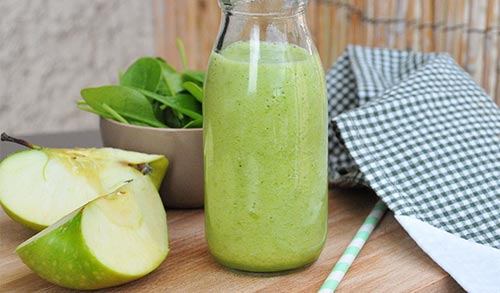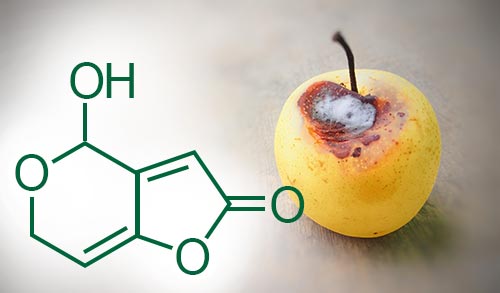From sweet red varieties, like Fuji, Red Delicious or Gala, to the tart and acidic green ones, like Granny Smith, it’s no surprise apples are among the world’s most widely consumed fruit.
However, food production is associated with food safety concerns. Food testing laboratories, though often behind the scenes, play an integral role in the daily checks and ongoing monitoring in food production and its accompanying supply chain. Fresh fruit and vegetable juices have caused outbreaks in the past, including food-borne pathogens in apple juice. Contamination of apples in the field and during processing highlights the importance of good agricultural practices and manufacturing processes.
Background: what is Patulin?
Patulin (PAT) is a mycotoxin derived from by a number of different moulds (fungi), such as Penicillium, Aspergillus clavatus and Byssochlamys, of which Penicillium expansum (P. expansum) is one of the more commonly encountered species. An organic compound, this toxin is classified as a polyketide. Patulin has a lactone structure and is heat-stable, so it is not destroyed by pasteurisation. It can be found in damaged or mouldy fruits, particularly apples and apple-products, including juices, puree and other processed forms of apple fruit. If contaminated apples are used to make juices, high levels of patulin may be likely to be carried through to the final product. Patulin has also been found in various foods such as grains, other fruits and vegetables.
Not usually found in alcoholic beverages or vinegar, Patulin declines during the microbial fermentation process with yeasts.
Control of Patulin in food is achievable through good agricultural, manufacturing and storage practices. As fungal contamination may affect crops grown under warm and humid conditions, refrigerated storage provides a control measure. Clean harvest bins and gentle handling of harvested fruit may minimise bruising and other physical damage, which may provide entry for Patulin as well as other microorganisms through the protective layer of skin or seed cavity.

Patulin can occur in apples spoiled by moulds, such as the
P. expansum species.
Effects and risks
In humans, when consumed in high levels, Patulin has been found to cause nausea, gastrointestinal disturbances and vomiting.
Chronically it can cause genotoxic, neurotoxic, immuno-suppressive and teratogenic effects. At the cellular level, Patulin is believed to result in plasmatic membrane rupture as well as protein, DNA and RNA synthesis inhibition.
Health limits
Commonly affecting our clients in the farming and agricultural sector, growers and packers invest significant time and resources in applying good agricultural and hygienic practices to ensure food is safe and suitable for human consumption. Consequently, Patulin’s presence in Apple Juice is regulated in a number of countries. Most limits are set between 30 and 50 µg/L.
In Australia, although there is no limit currently set for Patulin under the Food Standards Code, as regulated by Food Standards Australia NEW Zealand (FSANZ), 'Juice Australia' members adhere to an action level of 50 µg/L for Patulin in the final product. Juice Australia members importing concentrated apple juice, will request each supplier to provide a Certificate of Analysis including Patulin testing.
Analysis
Patulin can be accurately detected by independent laboratory testing and requires derivatisation of the compound prior to analysis by GC-MS. This is a specialised analytical testing method that combines gas chromatography and mass spectrometry to identify different substances within a liquid or volatile sample and is applied to identify unknown samples, contaminants or residual solvents.
In one sampling exercise, the team at MPL Laboratories was required to run a routine test for the detection of Patulin in apple juice. On arrival of the Patulin standard, our Organics team performed a test run with a commonly utilised derivatising agent. The team also applied another agent, MTBSTFA.
It was found that MTBSTFA presented a worthwhile addition, resulting in a sharper peak that produced a derivative more stable than the classical method.

Patulin as a chemical compound
A mycotoxin produced by several species of Aspergillus, Byssochlamys and Penicillium, Patulin is an organic compound classified as a polyketide. Represented by the formula, C7H6O4, its chemical structure is: 4-hydroxy-4H-furo [3,2c] pyran-2[6H]-one. Other attributes: molar mass of 154.12 g/mol. Heat-stable, Patulin is not destroyed by pasteurisation or thermal denaturation. Stability following fermentation is also reduced.

Laboratory reporting of Patulin by GC-MS analysis
This request was received on extremely short notice and as an urgent request. Our dedicated team took measures to immediately commence analysis at a fast turnaround time (TAT) that ultimately exceeded our client's expectations. We are equally proud to ensure our clients always receive accurate, reliable reporting at fast turnaround times that are aligned to project requirements and enable more informed decisions.
Testing for Patulin
MPL Laboratories provides leading laboratory testing services for Patulin to ensure compliance with strict regulations in place. Using advanced testing methods and the latest laboratory technology, quality results can be available at fast turnarounds that meet your project needs. To find out more about MPL Laboratories’ Patulin testing services as well as our broad offering of other analytical services, reach out to us today.